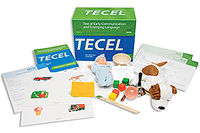TECEL: Test of Early Communication and Emerging Language
TECEL: Test of Early Communication and Emerging Language
Revision of the Nonspeech Test!
Now you can assess the language abilities of infants and toddlers; or test older individuals who have moderate to severe language delays.
Ages: 2 weeks to 24 months (standard scores, percentiles, and age equivalents); older children, adolescents and adults who have language delays (age equivalents only)
Testing Time: 15 to 45 minutes
Administration: Individual observation and/or parent/caregiver interview
The Test of Early Communication and Emerging Language (TECEL) assesses the earliest communication behaviors and emerging language abilities in infants and toddlers up to 24 months old. It is well-constructed, reliable, practical, research-based, and theoretically sound.
The TECEL is a revision and standardization of Mary Blake Huer's Nonspeech Test, a well-regarded assessment used with both typically developing young children and with older individuals with moderate-to-severe language delays.
The TECEL can be used by:
- Speech Language Pathologists
- Early Intervention and Early Childhood Professionals
- Special Educators
- Psychologists
- Diagnosticians
- Assistive Technology and AAC Specialists
- and related professionals.
It can be used to: (1) assess and chart communication and language strengths and weaknesses and design intervention plans, (2) make estimates about future language development, and (3) serve as a research tool for investigating early communication and emerging language.
Statistical and Technical Characteristics of the TECEL
- Norms - The TECEL is normed on 558 children between the ages of 2 weeks and 24 months from 28 states. The sample is demographically representative according to U.S. Census projections for 2010.
- Reliability - The TECEL evidences a consistently high degree of reliability related to content (.94), time (.87), and scorer differences (.82). The TECEL possesses relatively little test error and test users can have confidence in its results.
- Validity - The TECEL provides strong qualitative and quantitative evidence of validity, including high correlations with age and cognitive and language abilities.
Other Special Features of the TECEL
- Includes both receptive and expressive color coded items for easy diagnostic analysis of results.
- Flexible administration options include Interview, Observation, and/or a combination of both.
- Recognizes the continuum from pre-linguistic communication behaviors to symbolic forms in emerging language.
- Can be administered to verbal and nonverbal respondents and is suitable for assessing individuals who communicate by means other than speech.
- Test materials and interview questions are designed to be cross-cultural in content, free of jargon or difficult to understand concepts, and are appropriate for all ages.
- The Informal Assessment and Intervention Plan guides clinicians in analyzing performance on the test, developing recommendations, and generating an Intervention Plan.
- The manual includes case examples.
- The kit contains all necessary art and objects to administer the test.
- All pictures are drawn in full color for an appealing look and laminated for durability.
- All objects have been tested for choke hazard, and certified non-toxic.
COMPLETE TECEL KIT INCLUDES: Examiner's Manual, Picture Plates, 25 Examiner Record Booklets, 25 Informal Assessment and Intervention Plans and an Object Kit, all in a sturdy storage box. (©2011)



